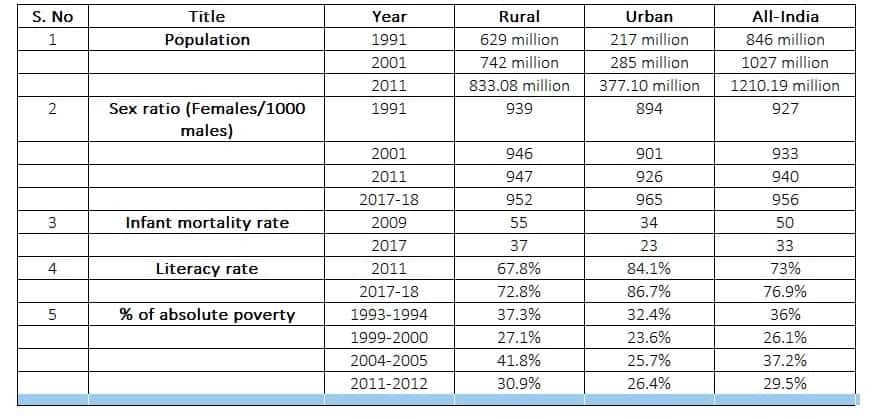Rural development is a wide field with various needs that arise for varying population groups. This is a systemic problem that has existed throughout free India’s history which doesn’t have any one size fits all solution. It is vital to recognize that in a country like India, improving the quality of rural life would have several downstream advantages like curbing increasing migration to cities, improve the socio-economic standards for the large majority of the population and tackling the issue of rampant and generational poverty.
This article was submitted by Hitesh Kishore, Great Lakes Institute of Management, Gurgaon
If India wants to expand its economy to have a $5 trillion valuation by 2025, then the ideal place to concentrate on would be the rural populace. Every government of India since Independence has taken cognisance of this issue and taken a wide variety of steps to tackle this in different ways. The very first 5-year plan undertaken by Jawaharlal Nehru was focused at the primary sector which is predominantly rural. Since then, there have been several other broad based and micro targeted schemes that seek to improve the livelihood of the rural poor.
The MGNREGA which guaranteed 100 days of job for the rural workers is perhaps the largest and most well-known of the government schemes for rural development. The current government has also implemented several schemes like DISHA, Gram Swaraj Abhiyan, Ujjwala yojana and several more. There is certainly no dearth of government intervention and the government has consistently spent over 10% of the GDP directly and directly for some form of rural development. But the question still looms, is it having any impact?
Table of Contents
Statistics and measurements of rural development

The above given statistics paint a very diverse view of the rural urban divide and the show that there are no simple conclusions that can we can derive at face value. But we can make some broad estimations on how it far we have come and what more needs to be done.
The given 5 indicators of population, sex ratio, IMR, literacy rate and % of absolute poverty are the best indicators of development and used as the standard by several different agencies and world governments.
Broadly we can say that we have made significant advances in very short time and that urban India has been faster in change and development while rural India lags behind. We have made drastic advances but it is still underwhelming due to our population size and the fact that rural development has been unable to keep pace with the urban development. In almost all the indices, it is urban India which holds the edge and even if urban lags behind, it has been able to cover up its deficiencies in a short time.
Conclusions from the data
One of the major takeaways has been that irrespective of government, there has been some improvement in all our indices. It would seem that our development is agnostic of political affiliations especially in urban pockets. The most worrying index has been the rising population especially in the rural areas which is unsustainable.
Most economists agree that increasing the population without the necessary socio-economic infrastructure in place will lead to wide spread inequalities and social unrest. The inescapable conclusion is that the government has indeed spent a lot of time, money and resources to improve rural development but still a lot more is needed beyond just government intervention. This is indicative of the fact that to ensure the last mile connectivity the government interventions are alone not enough.
It needs a sustained participation by the civil society, NGOs and the general populace who need to recognize the valuable role they have to play and begin its implementation. This will place more emphasis on the non-governmental entities and participation by individual citizens. We can also conclude that government interventions can only go so far as there are systemic problems like a large amount of leakages as corruption or excessive bureaucratic framework which kills any innovation or scheme the government tries to implement.
Charting a way forward
The way forward must be a de-centralisation system where by the local bodies and gram panchayats are empowered to work more independently and given more funds and autonomy in their functioning. This has a two-fold effect in reducing the responsibility on the government enabling it work on larger and more pressing issues and it also enables more micro targeting of the problems by the people who are better informed about the local issues.
This system was the idea behind the push for local self-government in 1991 but it has several implementational issues like a lack of funds and no proper elections for the gram sabhas or municipal corporations. This needs to be revisited and adequate divulsion of power must be done in a systematic and permanent manner.
Another step forward can be increasing the government spending on primary and secondary education especially in rural areas. As the people become more aware, they will in turn realise the ways by which they can work overcome their own shortcomings and emancipate themselves.
We can note that none of this is going to happen overnight and without sustained public scrutiny and governmental responsibility. Coming back to the question is the government doing enough, the answer can only be that the government can only do so much and that it is up to us to eventually be the change we wish to see.

Users not registered with Strictlylegal can Email us their content and the same are posted through this account. In case of abuse, kindly let us know at [email protected]




